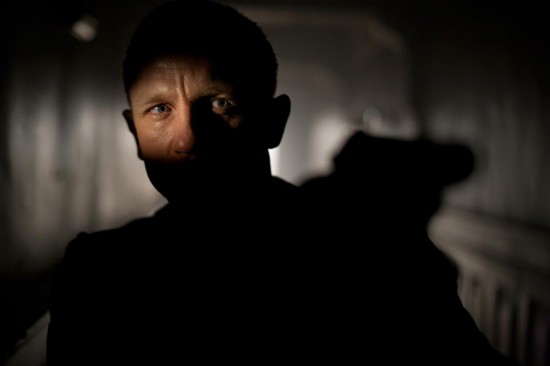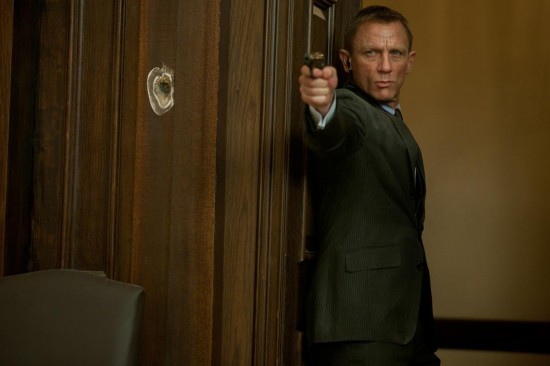On The 'Skyfall' Set Bond And Bardem Engage In A Catacomb Confrontation
The twenty-third James Bond film, which once again stars Daniel Craig and is directed by Sam Mendes, is called Skyfall. As it turns out, in one sense, the title has a very nearly literal implication. In the culmination of a chase scene that winds through and beneath London, the villain Silva, played by Javier Bardem, causes an explosion in a catacomb chamber underneath a London tube station. As a result, a train crashes down on Bond's head.
Skyfall has been shooting at the massive Pinewood Studios west of London, and on the tremendous 007 stage at that location the production replicated a large section of tube tunnel and the accompanying platform, and created both the chamber in which Bond and Silva have their confrontation, and the full-size train that crashes into it.
Last week I went to Pinewood to see part of that confrontation being filmed. While Sony and EON Productions are reluctant to give too much away at this point, still six months away from the late October/early November release of the film, we learned more than a few new things about the third outing of our modern James Bond, and I'll detail them below.
Because EON has been quite good about keeping the real plot details of Skyfall quiet, all we really know is that the story involves M's past. An element from that past threatens to disrupt MI6 and everything M (Judi Dench) has built. One of the key pieces of the puzzle is Bardem's character Silva, seen in early paparazzi photos dressed as a London police officer, with blond locks barely hidden under the brim of his hat.

Costume designer Jany Temime, who also costumed the last six Harry Potter movies, as well as In Bruges and Children of Men, says her version of the uniform is "more slinky, more like it should be," and all part of the film's heightened reality. She explained, "I was always thinking that in my wildest dream a real police officer would come to me and say "this looks really good! is that our uniform?" and I would say, "Almost.""
Javier Bardem, meanwhile, is not sporting dyed blond hair for the whole shoot, leading to the supposition that his character's disguise includes a wig. Asked about that detail, he goes for the broad tease. "Oh, you noticed that, did you?"
Prior to the Pinewood shoot, the production was on the streets of London, shooting in famous locations around Parliament, and in a disused part of Charing Cross Station, which stood in for Temple Station. We don't know how all the various locations link together in the film's storyline, but we do know that at some point Bond follows Silva into the tube station, chasing him through a tunnel and into the catacombs below the tube station. Bond finally has a bead on Silva as the villain attempts to ascend a ladder to safety, Silva triggers a bomb that blows open the catacomb wall and roof behind Bond.

Special Effects Supervisor Chris Corbould, whose first Bond credit was on Moonraker, and who now frequently works with Christopher Nolan, designed the tube train crash sequence with Sam Mendes and they worked with writers Neal Purvis and Robert Wade, and John Logan, to fold it into the script. That process began in October, with the sequence really put into the script in November, which led to months of animatics and nuts and bolts calculations about how to make it work.
(In that respect this Bond seems a bit more organically-grown than the last, with ideas coming from all corners. Daniel Craig would later tell me "I've been part of the process with this one from the very beginning, the inception of the script, and the ideas.")
Corbould described the setup as "a big roller coaster ride, really," and indeed the design for this effects sequence is bulky, but elegant: two production-fabricated replica Tube carriages, each weighing about five tonnes rather than the 25-30 tonnes of real carriages, are elevated on track about 20 feet over the floor of the 007 stage. Near the ceiling of the catacomb set, the broken track ends curve slightly downward, and a monorail supports the carriages from above.
While we were allowed to watch the explosion set off by Silva, the full aftermath, with the crashing train, was to be shot the following day. The plan was explained like so: get the carriages up to speed on the elevated track, with the monorail keeping them on course as they go off the track and dive-bomb the catacomb set ceiling, which was fitted with breakaway elements. Some digital work will supplement the practical effect, but it was quite impressive to see the large-scale setpiece just before the trigger was pulled.
This effect is essentially a one-time thing, given the week-plus reset time required to patch everything up should another go be required. So as we walked around Pinewood the sense was of a crew that was focused and, while not tense, certainly rejecting distractions in order to ensure the viability of the first take. We also saw evidence of other practical effects, with scale-model helicopters and a scale Aston Martin being worked on as we peeked into various areas of the studio set. Throughout my visit, there was great conversational emphasis on the way that Mendes has really allowed the characters to come to the fore in a way that is a slight change from other recent films, and it seems like the practical effects fit right into Mendes' working style.
"He comes from a very theatrical, character-based story background," Corbould said, "which has worked really well from my point of view. He has taken it from an out and out sheer action movie to an action thriller with big characters. To me that's very important, that the storyline and characters are involved in the action... Because Sam hasn't got a history with action films he thinks outside the box."
 Roger Deakins (No Country For Old Men) is the cinematographer, and it was a small joy to see him wandering around set, checking the last touches on the lighting. He's shooting the film on the digital Arri Alexa. Because shooting digitally requires far less light than working with film stock, the set was fairly low-lit. Deakins first shot digital on In Time — a film which didn't inspire the confidence I'd like to have in his digital work. Without having seen any of Skyfall timed and graded, I can't declare that this film will look better. But on the monitor, at least, what I saw looked far better than In Time.
Roger Deakins (No Country For Old Men) is the cinematographer, and it was a small joy to see him wandering around set, checking the last touches on the lighting. He's shooting the film on the digital Arri Alexa. Because shooting digitally requires far less light than working with film stock, the set was fairly low-lit. Deakins first shot digital on In Time — a film which didn't inspire the confidence I'd like to have in his digital work. Without having seen any of Skyfall timed and graded, I can't declare that this film will look better. But on the monitor, at least, what I saw looked far better than In Time.
The lighting design, used deep shadow to accentuated the depth and shape of the set. Edges of shadow modeled the actors' physical stature well, and accentuated the profiles and strong features of Craig and Bardem. The chamber in which we saw them shooting was partially flooded with water, with six to eight inches of dyed-black water requiring the crew to slosh around in Wellingtons and shorts. I expect we'll see that turning into a source of lighting accents when the scene is finished and cut.
(I asked if I might speak to Roger Deakins, to which the unit publicist responded "he doesn't like to speak to... anyone, really. You might be lucky to get eyes in your direction, or a smile.")
Meanwhile, as if the 59,000 square-foot 007 stage wasn't big enough, there were two other large sets at Pinewood. One was being put up, the other struck. The new set was a three-tier casino that in the film will be set in Macau. There is a large water tank on the outskirts of Pinewood, with a large blue screen at one end. That tank, decorated with two very large floating dragon heads, was used to shoot parts of the water-based approach to the casino. The interior of the gambling den was still in rough form when we walked through, but even at that point it looked impressive, as metalwork imported from China was being added to decorate the deep burgundy walkways and carved wooden dragons that surround a central gambling area. Gold accents provided definition to the set, which was also fitted with a fighting pit over which crossed walkway allow a great view for onlookers.
The set being struck, meanwhile, is a replica of a deserted, blasted-out city on the island of Hashima, near Japan. This is where Bond and Silva first meet, and the brown and grey buildings and streets felt desolate and isolated. That was part of the effect of seeing the set on its way to being dismantled, but we also got to look at the set dressings that had already been stripped from the main area — bikes, boxes, and other urban detritus — and those materials were all sad and dirty, as well.
Meanwhile, as we were in Pinewood, Alexander Witt was already in Turkey with the film's second unit, with the bulk of the production soon meant to travel to the country to continue the shoot for the last six weeks or so of production. The scenes to be done in Turkey involve a lot of the film's action, including yet another train sequence. (That sequence was reported early on as being scouted in India.) Unfortunately details on that action was all off-limits to us.
Tomorrow and through the week we'll have more from the set of Skyfall, including other interviews with Craig, Bardem, Judi Dench, and others.
